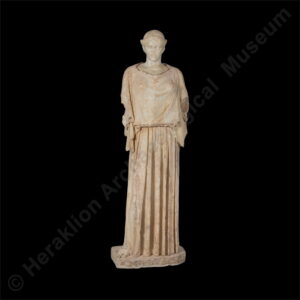
A female statue type of the Archaic period with standardised characteristics. It appears in the 7th century BC and continues to evolve until the end of the Archaic period. Like the corresponding male kouros, the kore (meaning “maiden”) expresses the aristocratic ideals of the “good and virtuous” young woman of the time. She is depicted in a standing frontal pose, wearing a chiton and himation (or more rarely a peplos), often with an elaborate hairstyle with long locks, and rich jewellery. The face, like that of the male version, features the “Archaic smile”, a discreet smile that gives the figure a lively expression. In some cases the kore is holding out her hand, elbow bent, with some offering (flowers, fruit, birds). The figures gradually acquire a rudimentary movement, one foot forward and the corresponding hand lifting the garment. Many statues of this type preserve traces of vivid colours that originally adorned the hair, jewellery and clothing. Marble kore statues were dedicated as votive offerings to sanctuaries and set up as grave markers on the tombs of illustrious women in cemeteries.